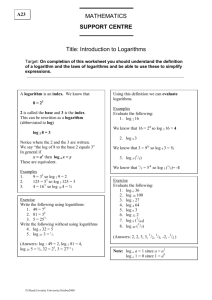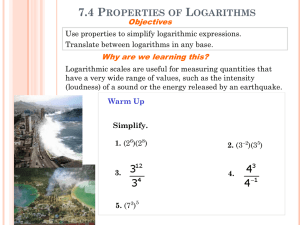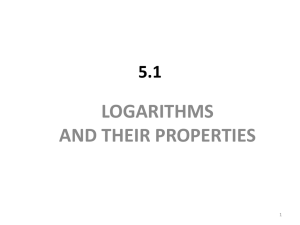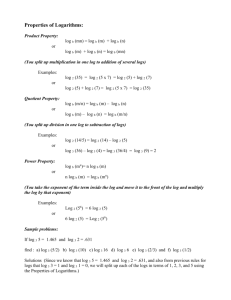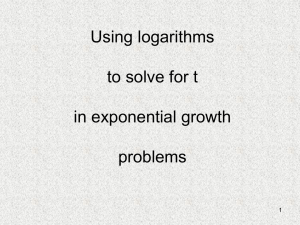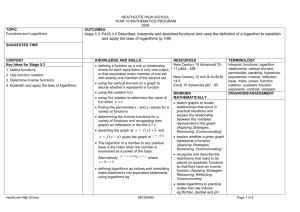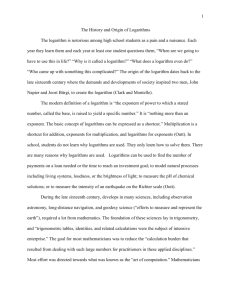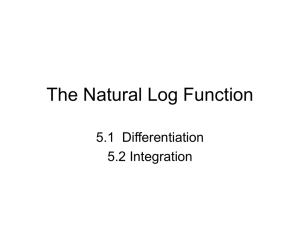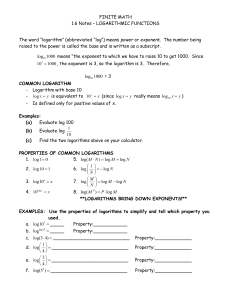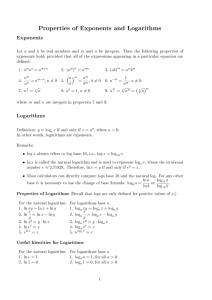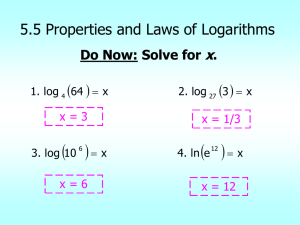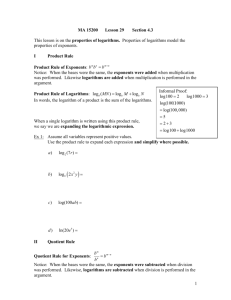A History of Logarithms - Department of Mathematics | Illinois State
advertisement
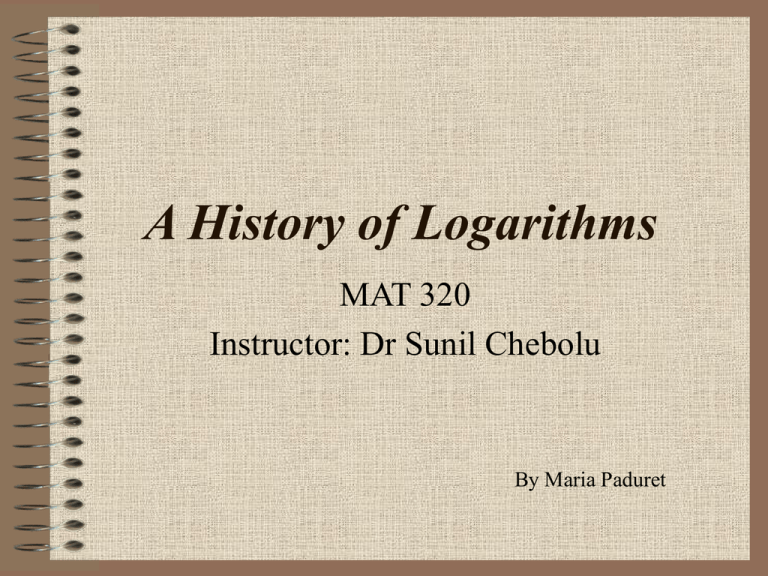
A History of Logarithms MAT 320 Instructor: Dr Sunil Chebolu By Maria Paduret How LOGARITHMS appeared? People didn’t know how to multiply or divide big numbers. These calculations were necessary not only in Commerce and Business, but also in Astronomy, Engineering, and Science. There were “calculation centers” where people were bringing their problem, paying and coming back after a few days for the answer. John Napier 1614 announced that from that day on, everybody will be able to solve these problems: the multiplications and divisions will be replaced by simple additions and subtractions Joost Burgi 1620 a clockmaker from Switzerland published almost the same thing regarding logarithms. He was also well known as being a maker of astronomical instruments and mathematician. Objective The objective of both men was to simplify mathematical calculations. Napier’s approach was algebraic while Burgi’s was geometric. • “Mirifici Logarithmorum Canonis Descriptio” (Description of the wonderful canon of logarithms) by Napier published in 1614 • There is evidence that Bürgi arrived at his invention as early as 1588, six years before Napier began work on the same idea. By delaying the publication of his work to 1620, Bürgi lost his claim for priority in historic discovery. HOW? The logarithms have a very interesting property: log (ab) = log a + log b. Therefore, with precise tables of logarithms, if we want to multiply two numbers a and b, we’ll have to look up into the table for log a and for log b, we add the two values (S), and then we go back into the table and find out what number has S as a logarithm. This number is the answer of ab. Example Multiply 15.27 by 48.54 log(15.27) = 1.1838 and log(48.54) = 1.6861 Add the logarithms 1.1838 + 1.6861 = 2.8699 It is possible to use the log tables backwards, but most people would have turned to the next page for the table of antilogarithms The answer is 741.1 Logarithms Definition: A logarithm is the exponent or power to which a number a, called the base, I raised to yield a specific number: Let a > 0 be a real positive number, a nonequal to 1 . Considering the equation: ax = N, N > 0 (1) (1) has a unique solution, and this solution is: x = logaN (2) and we call it logarithm of N to the base a. From (1) and (2) we get the following equality: alogaN = N If in (1) we make x = 1, we’ll obtain a1 = a hence logaa = 1 Properties of Logarithms • loga(AB)=logaA + logaB The property can be given also for n positive numbers A1,A2,...,An: • loga(A1A2…An) = logaA1 + logaA1 + logaA2 +…+ logaAn. • loga (A/B) = logaA- logaB • loga (1/B) = -logaB • logaAm=mlogaA, where A is a positive number loga (A1/n) = (logaA )/n This is a particular case of the previous property, when m=1/n. • logaA = logbA * logab Why do you use logarithms? • To find the number of payments on a loan or the time to reach an investment goal • To model many natural processes, particularly in living systems. We perceive loudness of sound as the logarithm of the actual sound intensity, and dB (decibels) are a logarithmic scale. We also perceive brightness of light as the logarithm of the actual light energy, and star magnitudes are measured on a logarithmic scale. • To measure the pH or acidity of a chemical solution. The pH is the negative logarithm of the concentration of free hydrogen ions. • To measure earthquake intensity on the Richter scale. • To analyze exponential processes. Because the log function is the inverse of the exponential function, we often analyze an exponential curve by means of logarithms. • To solve some forms of area problems in calculus. (The area under the curve 1/x, between x = 1 and x = A, equals lnA.) References: http://www.spiritus-temporis.com/logarithm/history.html http://www.westcler.org/gh/Outtda/pdf_files/History_of_Logarithms.pdf http://www.humboldt.edu/~mef2/Presentations/HSU%20Colloquia/colloq2_4_9 9.html http://www.google.com/search?q=history+of+logarithms&hl=en&tbs=tl:1&tbo= u&ei=u5gvTNiTCsrsnQfo9_zYAw&sa=X&oi=timeline_result&ct=title&res num=11&ved=0CEkQ5wIwCg http://www.math.umt.edu/TMME/vol5no2and3/TMME_vol5nos2and3_a14_pp. 337_344.pdf http://www.stiintaazi.ro/index.php?option=com_content&view=article&id=3932 :istoria-matematicii-john-napier-scotianul-care-a-inventat-logaritmii-in1614&catid=171:istoria-matematicii&Itemid=124 http://en.wikipedia.org/wiki/Logarithm http://books.google.com/books?id=8uYGAAAAYAAJ&printsec=frontcover&dq =tables+of+logarithms&source=bl&ots=_Dsm62xbZB&sig=vdBYQEiE6eHdaHOEA9V3kjLU9I&hl=en&ei=jzIzTMzODYa0lQfwjom_Cw&sa= X&oi=book_result&ct=result&resnum=1&ved=0CBEQ6AEwADgK#v=one page&q&f=false Questions?
